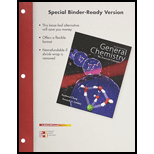
Concept explainers
Interpretation:
The value of
Concept Introduction:
The emission of radiation given by an energized hydrogen atom to the electron falling from a higher-energy orbit to a lower orbit give a quantum of energy in the form of light. Based on electrostatic interaction and law of motion, Bohr derived the following equation.
Where,
The electrons are excited thermally when the light is used by an object. As a result, an emission spectrum comes. Line spectra consist of light only at specific, discrete wavelengths. In emission, the electron returns to a lower energy state from
This transition results in the photon’s emission with frequency
When,
The speed, wavelength and frequency of a wave are interrelated by
Substitute the frequency formula and rearrange,
Therefore, this formula is used to find the wavelength of the given photon in the emission line process. For the absorption line process in which an electron is removed from the nucleus, the sign is changed as,
To find: Get the value of
Answer to Problem 7.34QP
The value of
Explanation of Solution
An electron in the hydrogen atom makes a transition from an energy state of principal quantum number
Here, Planck’s constant,
Hence, the photon energy change is
Therefore, the value of
The value of
Want to see more full solutions like this?
Chapter 7 Solutions
Loose Leaf Version for Chemistry
 ChemistryChemistryISBN:9781305957404Author:Steven S. Zumdahl, Susan A. Zumdahl, Donald J. DeCostePublisher:Cengage Learning
ChemistryChemistryISBN:9781305957404Author:Steven S. Zumdahl, Susan A. Zumdahl, Donald J. DeCostePublisher:Cengage Learning ChemistryChemistryISBN:9781259911156Author:Raymond Chang Dr., Jason Overby ProfessorPublisher:McGraw-Hill Education
ChemistryChemistryISBN:9781259911156Author:Raymond Chang Dr., Jason Overby ProfessorPublisher:McGraw-Hill Education Principles of Instrumental AnalysisChemistryISBN:9781305577213Author:Douglas A. Skoog, F. James Holler, Stanley R. CrouchPublisher:Cengage Learning
Principles of Instrumental AnalysisChemistryISBN:9781305577213Author:Douglas A. Skoog, F. James Holler, Stanley R. CrouchPublisher:Cengage Learning Organic ChemistryChemistryISBN:9780078021558Author:Janice Gorzynski Smith Dr.Publisher:McGraw-Hill Education
Organic ChemistryChemistryISBN:9780078021558Author:Janice Gorzynski Smith Dr.Publisher:McGraw-Hill Education Chemistry: Principles and ReactionsChemistryISBN:9781305079373Author:William L. Masterton, Cecile N. HurleyPublisher:Cengage Learning
Chemistry: Principles and ReactionsChemistryISBN:9781305079373Author:William L. Masterton, Cecile N. HurleyPublisher:Cengage Learning Elementary Principles of Chemical Processes, Bind...ChemistryISBN:9781118431221Author:Richard M. Felder, Ronald W. Rousseau, Lisa G. BullardPublisher:WILEY
Elementary Principles of Chemical Processes, Bind...ChemistryISBN:9781118431221Author:Richard M. Felder, Ronald W. Rousseau, Lisa G. BullardPublisher:WILEY





